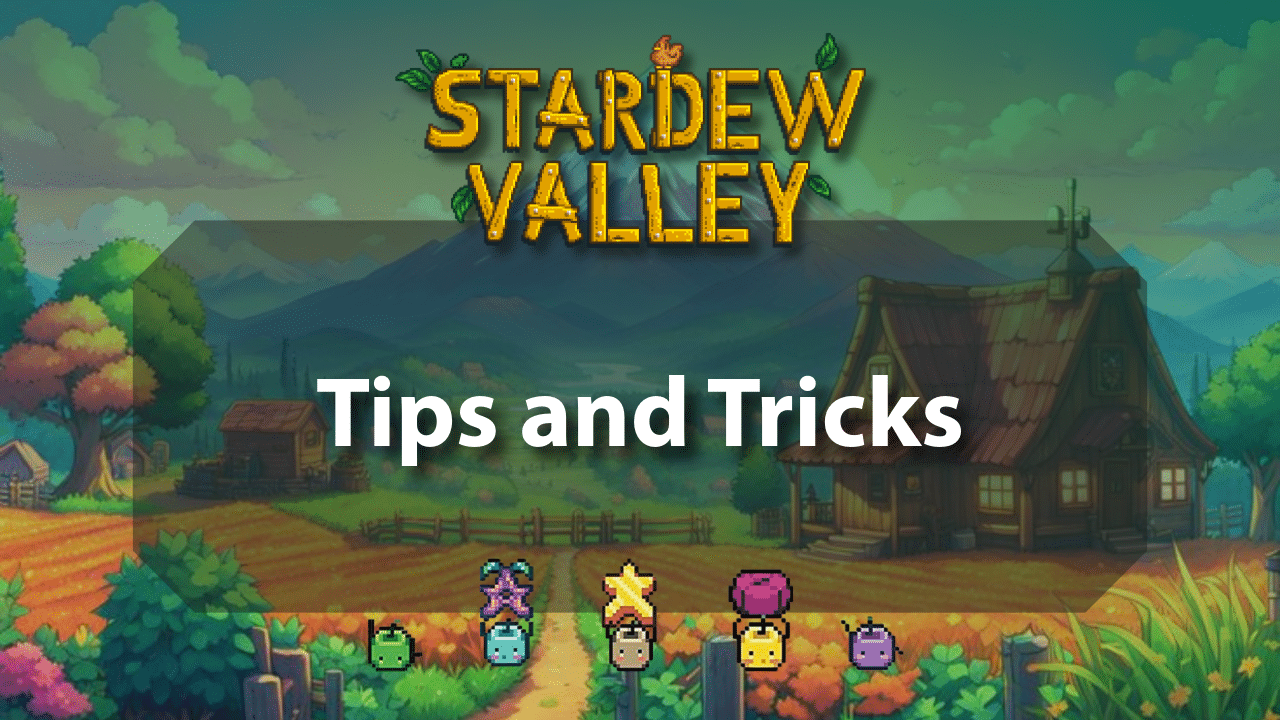
Introduction
Stardew Valley Tips and Tricks can help you optimize your farm, build strong relationships, and explore every aspect of the game efficiently. To start, clear your farm’s debris and plan your crop layout to maximize space and profit. Investing in crops that grow back, such as strawberries and blueberries, ensures a steady income without constant replanting. Watering crops daily is essential unless you unlock sprinklers, which save time and energy, allowing you to focus on mining, fishing, or animal care.
Upgrading tools at Clint’s Blacksmith shop is crucial for efficiency, making tasks like breaking rocks, chopping trees, and tilling soil much easier. Mining in the early game provides essential ores for upgrades and crafting, and delving deeper unlocks rare resources and valuable loot. Combat skills help in defending against monsters, ensuring you can explore the Mines safely while collecting materials for crafting and selling.
Building relationships with Pelican Town’s residents is just as important as farm work. Giving gifts and completing quests increases friendship, unlocking heart events, recipes, and even special perks, such as discounts or exclusive items. Keeping track of the calendar is vital, as missing birthdays or seasonal festivals can mean lost opportunities for relationship growth and rewards. Fishing, though challenging at first, becomes a steady source of income, especially when selling high-quality fish or crafting bait and tackle to improve efficiency.
Managing stamina wisely ensures you get the most out of each day, so eat food when needed and avoid staying out too late to prevent energy loss. Completing the community center bundles provides major benefits, such as repairing the greenhouse for year-round farming or unlocking new areas like the desert. Alternatively, choosing the JojaMart membership offers a different path by directly purchasing upgrades.
Seasonal changes impact your crops and activities, so plan accordingly by stocking up on seeds before a new season begins. Using farm buildings like coops and barns to raise animals diversifies your income and provides resources for artisan goods, which sell for higher profits. Foraging in each season offers free resources that can be used in crafting or gifted to villagers.
Investing in automation, such as kegs and preserves jars, turns crops into valuable goods, maximizing profits over time. Paying attention to the weather forecast helps plan daily activities, such as mining on rainy days or preparing for upcoming festivals. Following these Stardew Valley Tips and Tricks ensures you make the most of your journey, creating a thriving farm and experiencing everything the game has to offer.
Getting Your Farm Started
When you first arrive at your overgrown farm in Stardew Valley, you’ll find it covered in trees, rocks, and wild grass. While it may be tempting to clear everything immediately, a more strategic approach will help you conserve energy and resources. Start by clearing just enough space to plant the parsnip seeds you receive at the beginning, as they grow quickly and provide an early source of income while also helping you level up your farming skill. Water your crops daily by refilling your watering can at any nearby water source to ensure healthy growth.
As you break stones with your pickaxe and chop trees with your axe, you’ll gather essential materials like wood and stone. Wood is especially valuable early on for crafting chests, which help keep your growing inventory organized. Placing a chest near your farmhouse allows for easy access to tools, seeds, and harvested crops.
Managing your farm efficiently in the early days will make future expansions smoother. While clearing grass may seem like a good idea, it’s best to leave the tall grass that you can walk through until you have built a Silo. Using a scythe on grass after constructing a Silo converts it into hay, which is essential for feeding animals. This saves money over time, as you won’t need to purchase hay from Marnie’s Ranch.
Following these Stardew Valley Tips and Tricks will help you get off to a strong start, ensuring that your farm is well-organized and resource-efficient from the very beginning. By prioritizing smart resource management and careful planning, you’ll set yourself up for long-term success in Pelican Town.
Smart Choices for Early Income
In the early days of spring, visiting Pierre’s General Store is essential for acquiring more seeds to expand your farm. While parsnips provide a solid start, planting a variety of crops such as green beans, cauliflower, and potatoes helps diversify your income and prepares you for community center bundles. Potatoes are a great early investment due to their chance of yielding multiple potatoes per harvest, increasing overall profit. Cauliflower, while taking longer to grow, sells for a higher price, making it a worthwhile crop for long-term gains. Since Pierre’s shop is closed on Wednesdays, planning seed purchases in advance ensures you don’t lose valuable planting time.
Beyond crops, fishing can be a highly profitable activity early in the game. On the second day of spring, visiting the beach will trigger a cutscene where Willy gives you a bamboo fishing rod. Fishing may seem difficult at first, but practicing and increasing your fishing level makes it easier over time. Bubbling spots in the water indicate areas where fish bite more frequently and are often of higher quality, leading to better profits.
Selling fish at Willy’s shop provides a quick and reliable source of gold. Foraging is another useful way to gather resources without spending energy. Picking up wild fruits, flowers, and other seasonal items along the roads and in the forest can provide income and necessary items for community center bundles.
As you explore beyond your farm, the mines in the northern mountain area will become accessible. Mining ores and breaking rocks yield valuable materials such as copper, iron, and gold, which are essential for crafting, tool upgrades, and completing bundles. Valuable minerals and gems found in the mines can be donated to the museum or sold for extra income. Entering the mines requires preparation, as deeper levels introduce stronger monsters.
Bringing food helps restore energy and health, allowing you to mine and fight longer. Progressing through all 120 levels of the mine unlocks rare ores and powerful rewards, making it an essential part of farm development. Following these Stardew Valley Tips and Tricks will help you balance farming, fishing, and mining, ensuring a steady income and smooth progress through the seasons.
Essential Tips for a Smooth Start
Managing your farmer’s energy in Stardew Valley is crucial, especially in the early game when tools are basic and stamina is limited. Performing tasks like clearing land, planting crops, and mining quickly depletes your energy bar, so making the most of each day requires planning. Eating foraged items such as spring onions, berries, or mushrooms can help replenish energy without spending gold.
Cooking meals later in the game provides even better energy restoration, but early on, purchasing food from the Stardrop Saloon is an option if you have extra funds. Sleeping at the end of each day fully restores energy, but passing out from exhaustion will cost you gold and time. Managing stamina effectively allows you to maximize productivity and complete more tasks before the day ends.
Upgrading your tools at Clint’s Blacksmith shop is an important early goal. Basic tools require multiple swings to complete tasks, which drains energy quickly. Upgrading your axe, pickaxe, watering can, and hoe increases efficiency, allowing you to clear land, break rocks, and water crops faster while conserving stamina. Copper tools are the first upgrade, requiring copper bars and gold, and each subsequent upgrade further improves efficiency. Investing in tool upgrades early will make daily farm work easier and give you more time for other activities like fishing, mining, and socializing with villagers.
Constructing a Silo before clearing all the wild grass on your farm is a smart move, especially if you plan to raise animals. Once a Silo is built, cutting tall grass with a scythe automatically converts it into hay, which is stored for feeding livestock. This ensures you have a reliable supply of feed, especially during winter when grass stops growing. Without a Silo, cutting grass will not yield hay, meaning you’ll have to buy it from Marnie’s Ranch later, which can become costly. Keeping a chest inside your barn or coop next to the feed bin is helpful for managing extra hay, making feeding animals easier.
Checking the television in your farmhouse daily provides useful information that can help optimize your schedule. The weather forecast lets you prepare for upcoming rainy days, which allow you to skip watering crops and focus on other tasks like mining or fishing. The Fortune Teller provides insight into your daily luck, which affects the likelihood of finding geodes, getting better loot in the mines, and catching higher-quality fish. On high-luck days, it’s a great idea to go mining, as enemies will drop better loot and ores will spawn more frequently.
The “Living off the Land” program offers farming and foraging tips that change with the seasons, providing guidance on when to plant certain crops, where to find forageables, and how to maximize profits. Keeping track of the calendar and the notice board outside Pierre’s shop ensures you don’t miss important events, such as festivals, villager birthdays, and special quests. Participating in festivals can yield valuable rewards, and giving a villager a birthday gift significantly boosts friendship, unlocking heart events, recipes, and other benefits.
Caring for crops is essential for a successful farm, and protecting them from hazards ensures steady growth. Crows can eat crops, reducing your yield, so crafting a scarecrow as soon as you reach Farming Level 1 is important. Scarecrows cover a circular area and prevent crows from destroying plants within range. Avoid planting more than 15 crops until you can craft a scarecrow to minimize losses. Weeds can also damage crops if left unchecked, so clearing them regularly or placing fences around your farm helps keep them under control. Using sprinklers, unlocked at Farming Level 2, automates watering, saving time and energy that can be spent on other tasks.
Early in the game, you’ll come across the abandoned Community Center. Choosing to restore it by completing bundles unlocks major upgrades that improve life in Stardew Valley. Completing the pantry bundles restores the greenhouse, allowing you to grow crops year-round. The minecart repair bundle provides fast travel between key locations, saving time on daily activities. The fish tank bundles remove the glittering boulder near the mines, unlocking the ability to pan for ore and minerals.
The bulletin board bundles grant friendship boosts with villagers, unlocking new dialogues and benefits. When collecting items for the Community Center, check your inventory, as the icon will glow when you have an item needed for a bundle. Saving at least one of each crop, fish, and forageable item ensures you won’t miss out on completing bundles quickly. Alternatively, choosing to support JojaMart allows you to purchase upgrades directly, bypassing bundle requirements.
Inventory space is limited at the start, making early-game management challenging. One of the best early upgrades is purchasing the first backpack expansion from Pierre’s shop for 2,000 gold. This upgrade increases inventory slots from 12 to 24, allowing you to carry more tools, crops, and collected items without constantly returning to storage. Expanding inventory space significantly improves efficiency, making activities like mining and fishing much easier. The second backpack upgrade costs 10,000 gold and increases slots to 36, providing even more convenience as the game progresses.
Fishing is a great way to earn money and acquire ingredients for cooking. On the second day of spring, visiting the beach will trigger a cutscene with Willy, who gives you a bamboo fishing rod. Fishing may be difficult at first due to the minigame’s mechanics, but increasing your fishing skill makes catching fish easier over time. Look for bubbling spots in the water, as fish bite more frequently in these areas, increasing catch rates and profitability. Selling fish directly to Willy is a reliable source of income, and certain fish are required for Community Center bundles. As you level up fishing, you’ll unlock new rods, bait, and tackle to improve efficiency.
Mining plays a key role in upgrading tools, crafting, and generating income. The mines, located north of Pelican Town, become accessible early in the game. Mining provides ores needed for tool upgrades, and breaking rocks can yield valuable gems and geodes. Monsters in the mines drop loot, including coal and materials for crafting. Bringing food is essential to replenish health and stamina, allowing for longer mining sessions. Each floor presents stronger enemies and better resources, with deeper levels unlocking rare minerals and essential materials like gold and iridium. Progressing through all 120 levels grants access to the Skull Cavern, an even more challenging mine with valuable rewards.
By following these Stardew Valley Tips and Tricks, you’ll set yourself up for success by managing energy wisely, upgrading tools efficiently, and balancing farming, fishing, mining, and social interactions. While there are many strategies to explore, Stardew Valley is designed to be enjoyed at your own pace. Experimenting with different activities, building relationships with villagers, and expanding your farm over time will create a rewarding and personalized experience in Pelican Town.













